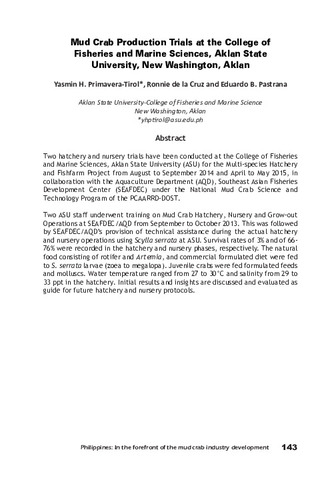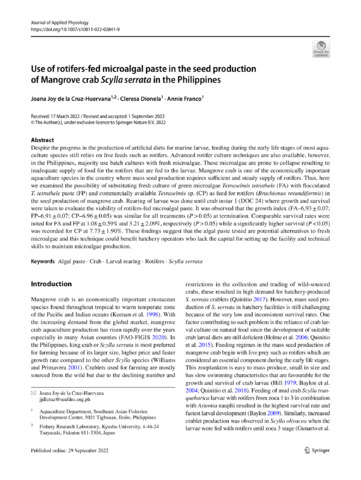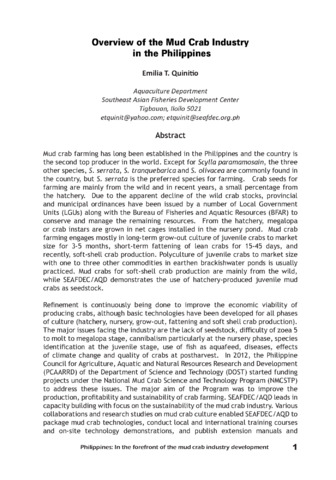| dc.contributor.author | Quinitio, Emilia T. | |
| dc.contributor.author | Parado-Estepa, Fe D. | |
| dc.contributor.author | Huervana, Joana Joy | |
| dc.contributor.author | Burlas, Michael Ray | |
| dc.contributor.editor | Romana-Eguia, Maria Rowena R. | |
| dc.contributor.editor | Parado-Estepa, Fe D. | |
| dc.contributor.editor | Salayo, Nerissa D. | |
| dc.contributor.editor | Lebata-Ramos, Ma. Junemie Hazel | |
| dc.date.accessioned | 2016-01-19T10:02:50Z | |
| dc.date.available | 2016-01-19T10:02:50Z | |
| dc.date.issued | 2015 | |
| dc.identifier.citation | Quinitio, E. T., Parado-Estepa, F. D., Huervana, J. J., & Burlas, M. R. (2015). Updates on the seed production of mud crab. In M. R. R. Romana-Eguia, F. D. Parado-Estepa, N. D. Salayo, & M. J. H. Lebata-Ramos (Eds.), Resource Enhancement and Sustainable Aquaculture Practices in Southeast Asia: Challenges in Responsible Production of Aquatic Species: Proceedings of the International Workshop on Resource Enhancement and Sustainable Aquaculture Practices in Southeast Asia 2014 (RESA) (pp. 207-212). Tigbauan, Iloilo, Philippines: Aquaculture Dept., Southeast Asian Fisheries Development Center. | en |
| dc.identifier.isbn | 9789719931041 | |
| dc.identifier.uri | http://hdl.handle.net/10862/2775 | |
| dc.description.abstract | Widespread interest in mud crab species is increasing because these are highly prized both in domestic and export markets. Among the three mud crab species commonly found in the Philippines, Scylla serrata, S. olivacea, and S. tranquebarica, S. serrata is preferred by farmers because it is larger and less aggressive than the other species. Likewise, S. serrata is the most widely distributed species in the Indo-west Pacific region.
Hatchery-produced seedstock are presently used by some crab farmers in their grow-out operations. In the hatchery phase, feeding mud crab larvae with shrimp formulated diets and natural food was found to reduce the occurrence of molt death syndrome, one of the major problems in seed production. Larvae given 25% formulated diet (FD) + 75% natural food (NF; rotifers and Artemia) and 50% FD + 50% NF showed better performance than those larvae fed 100% FD, 100% NF and 75% FD + 25% NF indicating that usage of natural food, especially the expensive Artemia, can be reduced. Since the early crab instar (C) produced in the hatchery need to be grown further before stocking in grow-out ponds, two phases of nursery culture have been developed. C1-2 are grown to 1.5-2.0 cm carapace width (CW) size in the first phase and further grown to 3.0-4.0 cm CW in the second phase. Nursery rearing is done in net cages installed in ponds for easy retrieval. A combination of mussel or trash fish and formulated diet is used as feed.
Domestication of the mud crab S. serrata as a prerequisite to selective breeding has been done at SEAFDEC/AQD. Likewise, defining criteria for the determination of quality of newly hatched zoeae for stocking in the hatchery was initiated. Newly hatched zoeae were subjected to starvation and stress test using formalin. Starvation failed to elicit responses that were significantly different between the good and poor quality larvae hence it is not suitable for larval quality evaluation. Based on three-year data, the formalin stress test gave mean cumulative mortalities of 2.38±0.32, 8.24±0.88, 20±1.58 in good quality larvae, and 43.74±2.39 while 22.93±4.19, 63.68±7.17, 84.29±3.88 and 97.65±1.06 for poor quality larvae at 0 (control), 20, 30 and 40 ppm formalin, respectively. As formalin level increased, cumulative larval mortality also increased regardless of the quality of the larvae. Formalin stress test proved to be a reliable method to determine whether a batch of newly hatched zoeae was of good or poor quality. | en |
| dc.language.iso | en | en |
| dc.publisher | Aquaculture Department, Southeast Asian Fisheries Development Center | en |
| dc.subject | Scylla tranquebarica | |
| dc.subject | Scylla serrata | |
| dc.subject | Scylla olivacea | |
| dc.subject | Scylla spp. | en |
| dc.subject | Mud crab | en |
| dc.subject | Quality seed stocks | en |
| dc.subject | Domestication | en |
| dc.subject | Philippines | en |
| dc.subject | hatcheries | en |
| dc.title | Updates on the seed production of mud crab | en |
| dc.type | Conference paper | en |
| dc.citation.spage | 207 | |
| dc.citation.epage | 212 | |
| dc.subject.asfa | starvation | en |
| dc.subject.asfa | seed (aquaculture) | en |
| dc.subject.asfa | Biological stress | en |
| dc.subject.asfa | feeding | en |
| dc.subject.asfa | mortality | en |
| dc.subject.asfa | trade | en |
| dc.subject.asfa | feeds | en |
| dc.subject.asfa | seed production | en |
| dc.subject.asfa | cultured organisms | en |
| dc.subject.asfa | Larval development | en |
| dc.subject.asfa | crab culture | en |
| dc.subject.asfa | aquaculture economics | en |
| dc.subject.asfa | rearing techniques | en |
| dc.subject.asfa | nursery ponds | en |
| dc.subject.asfa | fish diseases | en |
| dc.subject.asfa | feeding experiments | en |
| dc.subject.asfa | crustacean larvae | en |
| dc.citation.conferenceTitle | Resource Enhancement and Sustainable Aquaculture Practices in Southeast Asia: Challenges in Responsible Production of Aquatic Species: Proceedings of the International Workshop on Resource Enhancement and Sustainable Aquaculture Practices in Southeast Asia 2014 (RESA) | en |
| dc.subject.scientificName | Scylla serrata | |



